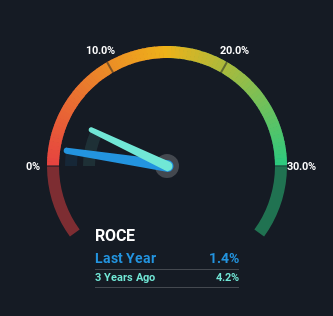- South Korea
- /
- Semiconductors
- /
- KOSDAQ:A251630
Returns On Capital At V-One Tech (KOSDAQ:251630) Paint A Concerning Picture
If we want to find a potential multi-bagger, often there are underlying trends that can provide clues. Firstly, we'll want to see a proven return on capital employed (ROCE) that is increasing, and secondly, an expanding base of capital employed. Ultimately, this demonstrates that it's a business that is reinvesting profits at increasing rates of return. Although, when we looked at V-One Tech (KOSDAQ:251630), it didn't seem to tick all of these boxes.
What Is Return On Capital Employed (ROCE)?
For those that aren't sure what ROCE is, it measures the amount of pre-tax profits a company can generate from the capital employed in its business. Analysts use this formula to calculate it for V-One Tech:
Return on Capital Employed = Earnings Before Interest and Tax (EBIT) ÷ (Total Assets - Current Liabilities)
0.014 = ₩2.1b ÷ (₩201b - ₩53b) (Based on the trailing twelve months to September 2024).
So, V-One Tech has an ROCE of 1.4%. Ultimately, that's a low return and it under-performs the Semiconductor industry average of 6.5%.
See our latest analysis for V-One Tech

Historical performance is a great place to start when researching a stock so above you can see the gauge for V-One Tech's ROCE against it's prior returns. If you'd like to look at how V-One Tech has performed in the past in other metrics, you can view this free graph of V-One Tech's past earnings, revenue and cash flow.
What Does the ROCE Trend For V-One Tech Tell Us?
In terms of V-One Tech's historical ROCE movements, the trend isn't fantastic. Around five years ago the returns on capital were 8.0%, but since then they've fallen to 1.4%. However, given capital employed and revenue have both increased it appears that the business is currently pursuing growth, at the consequence of short term returns. And if the increased capital generates additional returns, the business, and thus shareholders, will benefit in the long run.
On a side note, V-One Tech's current liabilities have increased over the last five years to 26% of total assets, effectively distorting the ROCE to some degree. Without this increase, it's likely that ROCE would be even lower than 1.4%. Keep an eye on this ratio, because the business could encounter some new risks if this metric gets too high.
The Key Takeaway
While returns have fallen for V-One Tech in recent times, we're encouraged to see that sales are growing and that the business is reinvesting in its operations. However, despite the promising trends, the stock has fallen 43% over the last five years, so there might be an opportunity here for astute investors. So we think it'd be worthwhile to look further into this stock given the trends look encouraging.
If you'd like to know more about V-One Tech, we've spotted 3 warning signs, and 2 of them are significant.
For those who like to invest in solid companies, check out this free list of companies with solid balance sheets and high returns on equity.
New: Manage All Your Stock Portfolios in One Place
We've created the ultimate portfolio companion for stock investors, and it's free.
• Connect an unlimited number of Portfolios and see your total in one currency
• Be alerted to new Warning Signs or Risks via email or mobile
• Track the Fair Value of your stocks
Have feedback on this article? Concerned about the content? Get in touch with us directly. Alternatively, email editorial-team (at) simplywallst.com.
This article by Simply Wall St is general in nature. We provide commentary based on historical data and analyst forecasts only using an unbiased methodology and our articles are not intended to be financial advice. It does not constitute a recommendation to buy or sell any stock, and does not take account of your objectives, or your financial situation. We aim to bring you long-term focused analysis driven by fundamental data. Note that our analysis may not factor in the latest price-sensitive company announcements or qualitative material. Simply Wall St has no position in any stocks mentioned.
About KOSDAQ:A251630
V-One Tech
Engages in the manufacture and sale of inspection equipment in South Korea, China, and internationally.
Mediocre balance sheet with low risk.
Market Insights
Weekly Picks

Solutions by stc: 34% Upside in Saudi's Digital Transformation Leader


The AI Infrastructure Giant Grows Into Its Valuation
Recently Updated Narratives
Many trends acting at the same time


Engineered for Stability. Positioned for Growth.


Staggered by dilution; positions for growth
Popular Narratives


MicroVision will explode future revenue by 380.37% with a vision towards success


NVDA: Expanding AI Demand Will Drive Major Data Center Investments Through 2026



